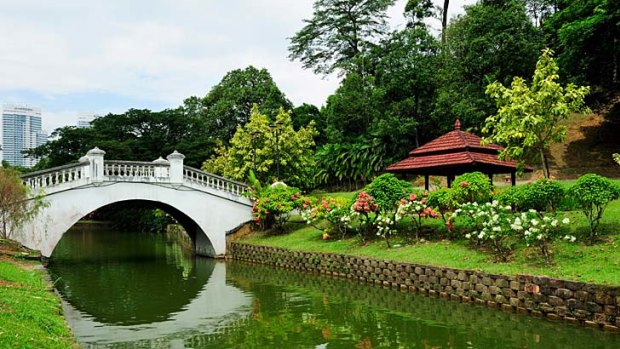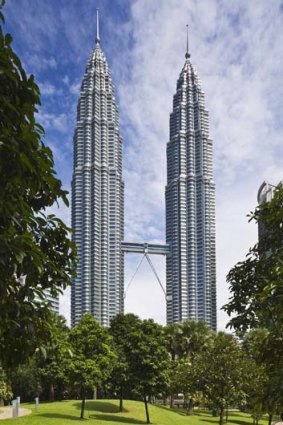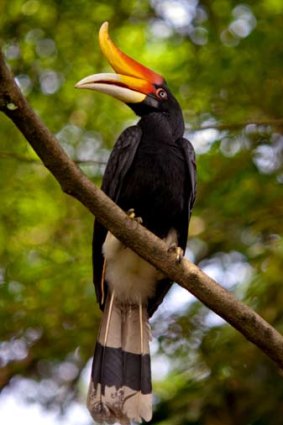
Greening up its image ... the Perdana Botanical Gardens is Kuala Lumpur's oldest and most popular park.Credit: Alamy
A city best known for its soaring structures, Kuala Lumpur is planting the seeds of some impressive environmental credentials, writes Kerry van der Jagt.
In a game of word association, mention Kuala Lumpur and most people think of skyscrapers - in particular, the pair of rockets known as the Petronas Twin Towers, the tallest twin buildings ever built.
At 452 metres they are impressive from any angle; from rooftop bars, the deck of the sky bridge or the top of the KL Tower, people stop to stare in wonder. The towers, like an Asian equivalent of the Eiffel Tower, have come to define the city. However, as the city grows ever upwards, it still has its roots planted firmly in the soil. Not only is Kuala Lumpur maintaining its green spaces, it is expanding them.

The 452-metre Petronas Towers.Credit: Getty Images
With the push to become a top-20 liveable city in the world by 2020, KL has embarked on a Greening Greater KL project - planting 100,000 trees, creating green corridors and pocket parks and expanding the Lakes Garden into a world class botanical garden.
A spinoff of the Greening Greater KL project is I Greened KL, a tourism environmental initiative where visitors can plant a tree in the city, keep up to date with its progress and hopefully return to see their trees. Already known as the Garden City of Lights, here are five of the best green spaces.
Perdana Botanical Gardens

A hornbill keeps guard.Credit: Alamy
Formerly known as the Lake Gardens, because of the sprawling man-made lake in the centre, the Perdana Botanical Gardens is the oldest and most popular park in Kuala Lumpur. Built in 1888 by Alfred Venning, the state treasurer of Selangor at the time, the park now covers more than 100 hectares.
As part of an extensive upgrade, thousands of new plants and trees were introduced in 2010 resulting in the park's change in status to a botanical garden. Situated just a few hundred metres from busy Chinatown, the landscaped hills and beautiful walking trails offer visitors and locals a respite from the hustle bustle of the city, in a picturesque location to relax and enjoy the calm serenity. There are children's playgrounds, jogging tracks, speciality gardens and a boathouse with row boats for hire.
Nearby attractions include the Islamic Arts Museum, National Mosque and National Museum. Admission is free. tourism.gov.my.
Tip: Don't underestimate the size; ask a taxi driver to drop you at one entrance and pick you up at another, or catch the trolley that runs throughout the park.
ASEAN Sculpture Gardens
A little-known collection of award-winning sculptures from Malaysia, Singapore, Indonesia, Thailand, the Philippines and Brunei Darussalam. Commissioned in 1981, the sculptures stand as a symbol of ASEAN cooperation. Near the National Monument, the six sculptures can be observed by following a walking trail through landscaped, tropical gardens.
Each sculpture has an interpretive sign providing insight into the individual artist's thoughts about his work. The garden is a place for quiet reflection, particularly after visiting the National Monument. Seven bronze human figures, each denoting one of seven qualities - courage, leadership, sacrifice, strength, suffering, unity and vigilance - stand as a symbol of peace and freedom. Admission is free. tourism.gov.my.
Tip: When walking past the reflection pool in the National Monument, look up at the ceiling for a bronze plaque dedicated to our very own Anzacs.
KL Forest Eco Park
(Formerly the Bukit Nanas Forest Reserve.) After shooting to the top of the 421-metre KL Tower, a stroll through the park at its base will bring you back to earth with a thump. This 10.5-hectare jungle within a concrete jungle was gazetted as a reserve in 1906 and is the last surviving patch of virgin forest left in the city. Originally home to tigers and elephants, the park is still home to two species of monkey (silvered langur and long-tailed macaques), squirrels, monitor lizards and white-throated kingfishers. There are several nature trails, including the Merbau Trail and the Jelutong Trail, and along the way you may witness some colourful butterflies and insects. Open daily from 7am to 6pm. Admission is free. forestry.gov.my.
Tip: Take one of the daily guided tours at 11am, 12:30pm, 2:30pm and 4:30pm, free with a ticket to the observation tower.
KLCC Park
Brazilian landscape artist Roberto Burle Marx was the magician who turned an old racecourse into the stunning 20-hectare KLCC Park. The aim of this, his last major work, was to strike a balance between the adjacent Petronas Twin Towers and nature - 1900 native trees and 74 species of palms were planted to showcase Malaysia's heritage of tropical greenery and to highlight the region's rich biodiversity.
Conservation was also a major consideration, with 23 of the mature and rarer specimens saved from the old Selangor Turf Club and transplanted into the park grounds. Some parts of the park feel a little contrived, especially the man-made Lake Symphony, but it is still a lovely green space. The park also features a sealed jogging track, children's playground, waterfalls and the stunning Asy-Syakirin Mosque. The park is open daily from 7am to 10pm. suriaklcc.com.my.
Tip: The 43-metre elevated bridge provides a great view of the park and the Petronas Twin Towers.
KL Bird Park
Located adjacent to the Perdana Botanical Gardens, the KL Bird Park is the tallest walk-in, free-flight aviary in the world and is home to over 200 species of birds.
Sprawled across eight hectares of valley terrain, the park is divided into four zones; Zone 1 and 2 make up the free-flight zone; Zone 3 is the Hornbill Park and Zone 4 is where the birds are kept in separate cages and mini aviaries. The main feature that distinguishes KL Bird Park from other bird parks is the concept of free-flight. So happy are these free-flying feathered friends, many of them continue to breed naturally while in captivity. The stars of the show are ostriches, hornbills, eagles, flamingoes, peacocks and parrots.
Next door is the Butterfly Park, with about 6000 butterflies representing 120 species. The bird park is open daily from 9am to 6pm. Entrance fees are 48 ringgit ($16) for adults and 38 ringgit for children. klbirdpark.com.
Tip: Don't miss the hornbill feeding at 11.30am.
Trip notes
Getting there
Malaysia Airlines operates 14 flights weekly from Sydney direct to Kuala Lumpur. Return economy flights from $885 during low season. malaysiaairlines.com.
Staying there
The Sheraton Imperial Kuala Lumpur is in the business district and has deluxe rooms starting from 481 ringgit ($155) a room a night, including taxes and surcharges. sheraton.com/kualalumpur.
More information
Sign up for the Traveller Deals newsletter
Get exclusive travel deals delivered straight to your inbox. Sign up now.